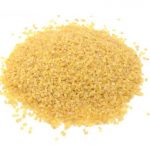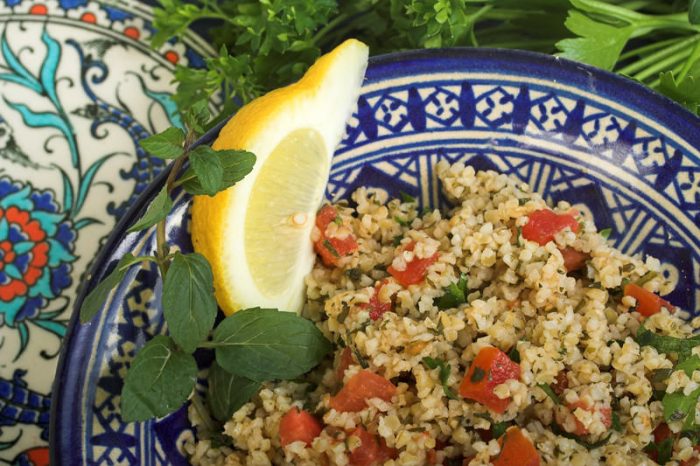Originating from Lebanon, tabouleh is one of the most popular salads from the Middle East. Usually served as part of a meze, there are regional variations but most salads contain a mix of bulgar wheat, tomatoes, onion and herbs (mint and parsley), with a lemon and olive oil dressing.
Delicious served with warm wholemeal flatbreads or pitta.
Skills Check
Follow a recipe; follow food safety & hygiene rules; tidy away; use measuring spoons; chop using bridge/claw technique safely; snip herbs with scissors; use a citrus squeezer; use weighing scales; use a measuring jug to measure liquids; garnish and decorate.
Allergens
Gluten
(Please note the allergens listed are indicative only. Allergens vary depending on brand; check the labels on the products you use.)
Equipment
Knife, Chopping Board, Bowls, Spoons, Measuring Spoons, Weighing Scales, Citrus Squeezer, Measuring Jug, Fork, Scissors.
Ingredients (serves 6 as a side dish):
- 70g bulgar wheat
- 2 large tomatoes, de-skinned and seeded
- 1 small red onion, peeled and finely chopped
- large bunch of flat leaf parsley
- small bunch of mint
- 3 tbsp olive oil
- 3 tbsp lemon juice
Method
- Place the bulgar wheat into a small bowl and cover with 50 ml of boiling water (ask an adult to do this). Stir and then leave to stand for 20 minutes.
- De-skin the tomatoes by scoring a small cross in the stalk end and placing in boiling water for 30 seconds. When cool enough to handle, peel off the skin, quarter and de-seed. Chop the remaining flesh and place in a bowl.
- Add finely chopped parsley, mint and onion to the bowl and mix well.
- Fluff the bulgar wheat up with a fork and add it to the tomato mixture.
- Drizzle over the olive oil and lemon juice, and mix well to combine and cover all of the ingredients.
So thinking about tabouleh ...

Tomatoes contain plenty of vitamins and minerals. They also contain lycopene, an antioxidant which can help protect us against certain diseases.
Herbs are healthy seasoning we can add to food for flavour. Many herbs are good sources of antioxidants; compounds which have been found to be extremely beneficial to health.
Nutritional Information
| - | Energy | 492 kJ / 198 kcal | 6% |
| Med | Fat | 6.7g | 10% |
| Low | Saturates | 0.9g | 5% |
| Low | Sugars | 2.2g | 2% |
| Low | Salt | Trace | <1% |
per 200g serving
% of an adult's reference intake
Typical values per 100g: Energy 246kJ / 59kcal
Notes
A traffic light system is used on nutrition labels to make it easier to see which foods and drinks are lower in calories, fat, sugar and salt. Try and choose more ‘greens’ and ‘ambers’ and fewer ‘reds’, and stick to smaller portions of ‘reds’.
Just because a recipe or a food has a red traffic light doesn’t mean you shouldn’t eat it. Understanding why a food or recipe might have a red light can be helpful. For example oily fish is high in total fat and so any recipe containing oily fish is likely to be ‘red’ for fat. But it is recommended that we eat oily fish at least once a week because the type of fat it contains is beneficial for our health.
% Reference Intakes are also shown. Reference Intakes are guidelines about the approximate amount of particular nutrients and energy required for a healthy diet (based on an average-sized woman doing an average amount of physical activity). Most children will require less than these Reference Intakes. The contribution of one serving of a food or drink to the Reference Intake for each nutrient is expressed as a percentage.




